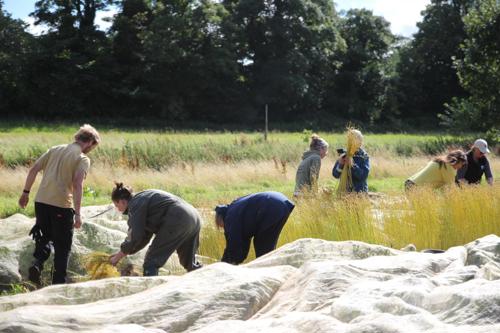This is the second year of our Growing Flax for Regenerative Textiles field lab. The trial is comparing the crop yield and straw height (which reflects fibre length and subsequent linen quality) of three Dutch flax varieties, with some triallists also testing the effectiveness of micro-clover to supress weeds. The network of fibre flax growers has expanded from three to nine, two of which are in south west England and the rest in Scotland.
Volunteers get hands-on for harvest
Flax needs to be pulled rather than cut, so teams of volunteers recently joined growers at Phantassie Farm and the James Hutton Institute's Balruddery Farm to hand-pull the crop. Phantassie is home to Fantasy Fibre Mill who are growing, processing and spinning flax into yarn in an effort to connect regenerative agriculture to ethical fashion.

Flax has a short growing season - from April/May to August in Scotland - and is ready to pull around 40 days after flowering. However, a very wet spring delayed sowing until mid-late May this year, meaning that some sites will not be harvested until early September. The process is described in more detail in our harvest update from year one.
Reviving Scotland's lost linen industry
The long-term aim of the field lab is to rekindle the lost linen industry in Scotland, by testing modern Dutch varieties of fibre flax in Scottish growing conditions. We are building Scottish specific growing knowledge, such as optimum sowing and retting times, and linking growers with processors and potential markets to support the development of localised processing and supply networks. We are trialling Dutch varieties because although Scotland was once a world leader in flax production and processing, there are no UK flax varieties commercially available since the industry died out in the mid-1900s.

The next stage after harvest is called retting (the process of breaking down the woody stem) and then drying the crop at each site. Then, it will be transported to Fantasy Fibre Mill to be processed into yarn, after which it can be woven into linen. Over the winter, samples of each variety will also be lab tested at Heriot Watt University to determine whether there are any differences in fibre strength and quality.
Plans for the year ahead
The trial is planned to continue for a third year in 2025. By this stage, we hope to have built up a practical knowledge base for future fibre flax growers, supporting the emerging regenerative textile industry across Scotland and the UK.

